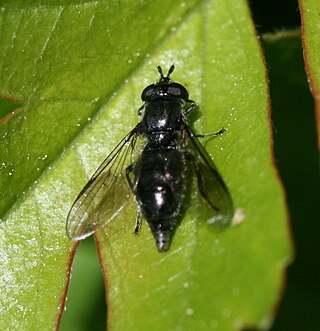
Pipiza is a genus Hoverflies, from the family Syrphidae, in the order Diptera. Most are dark hoverflies.

Pipizini is a tribe of small to medium-sized generally black hoverflies, although some species also have orange spots on their abdomen. This nondescript colouring can lead to some species being confused with other dark hoverflies from other tribes. The lack of a facial knob is a good defining feature which separates them from most of these other hoverflies. As with other species in the subfamily Syrphinae the larvae feed on aphids though there seems to be a preference for wax-secreting aphids e.g. Pemphigidae.

Pipiza noctiluca is a species of Hoverfly, from the family Syrphidae, in the order Diptera.

Pipiza austriaca is a species of hoverfly, from the family Syrphidae, in the order Diptera.

Pipiza bimaculata is a species of hoverfly, from the family Syrphidae, in the order Diptera.
Pipiza fenestrata is a species of hoverfly, from the family Syrphidae, in the order Diptera. They are found in Central Europe and live in deciduous forests. This species of Pipiza tends to live deeper in the forest than others in this genus. Males of this species possess holoptic vision, while females have dichoptic vision.

Pipiza lugubris is a species of hoverfly, from the family Syrphidae, in the order Diptera.

Pipiza luteitarsis is a species of Hoverfly, from the family Syrphidae, in the order Diptera.
Pipiza carbonaria is a species of hoverfly, from the family Syrphidae, in the order Diptera.
Pipiza fasciata is a species of hoverfly, from the family Syrphidae, in the order Diptera.
Pipiza notata is a species of hoverfly, from the family Syrphidae, in the order Diptera.
Pipiza signata is a species of hoverfly, from the family Syrphidae, in the order Diptera.

The Pipizinae is a subfamily of hoverflies. The subfamily Pipizinae was formerly considered a tribe within Eristalinae, but a phylogenetic analysis published in 2015 suggests it should be ranked as a separate subfamily
Pipiza nigripilosa, the pale-haired pithead, is a common species of syrphid fly observed in the eastern United States. Hoverflies can remain nearly motionless in flight. The adults are also known as flower flies for they are commonly found on flowers, from which they get both energy-giving nectar and protein-rich pollen. Larvae when known are aphid predators.
Pipiza puella, the sumac gall pithead, is a species of syrphid fly observed in eastern and Central United States, Canada and Norway. Hoverflies can remain nearly motionless in flight. The adults are also known as flower flies for they are commonly found on flowers from which they get both energy-giving nectar and protein rich pollen. Larvae when known are aphid predators.
Pipiza macrofemoralis, the large-legged pithead, is a fairly common species of syrphid fly observed in many locations across Northern North America.. Hoverflies can remain nearly motionless in flight. The adults are also known as flower flies for they are commonly found on flowers from which they get both energy-giving nectar and protein-rich pollen. Larvae, when known, are aphid predators.
Heringia elongata, the elongate spikeleg, is an uncommon species of syrphid fly observed in mainly eastern North America but scattered across the US Canadian border to the Pacific Coast. Hoverflies can remain nearly motionless in flight. The adults are also known as flower flies for they are commonly found on flowers, from which they get both energy-giving nectar and protein-rich pollen. Larvae are predators of Eriosoma lanigerum.
Trichopsomyia banksi ,the white-faced psyllid killer, is an uncommon species of syrphid fly observed across North America. Hoverflies can remain nearly motionless in flight. The adults are also known as flower flies for they are commonly found on flowers from which they get both energy-giving nectar and protein-rich pollen. Larvae are unknown but other members of this genus are psyllid, aphid and Phylloxera predators.





